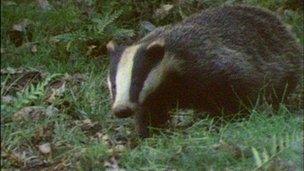A thousand fewer badgers in Gloucestershire cull zone
- Published
- comments

Working out the badger population numbers is proving difficult
It's impossible to actually count the number of badgers living in the Gloucestershire cull zone so we have to rely on estimates.
They've oscillated wildly over the past twelve months as various different methods of counting are used. The badger population itself may naturally vary too.
The first estimates, of up to 1,800 badgers, came from those involved in the cull and were widely seen as far too low.
English Nature then carried out its own research and came up with numbers, 4,079 badgers, that were so high they led to the cull being postponed for a year as those responsible doubted they could cull so many.
That English Nature estimate has slowly been revised down and now we suddenly find ourselves in a position where the latest population predictions are much lower, 2,350 badgers, although not as low as when we first started all this a year ago.
How many?
So if you can't count all the badgers how do you work out the population?
Well, you can rely on historical data but now we increasingly rely on DNA evidence.
Researchers put out hair traps, pieces of barbed wired, across badger runs near the setts. As the badgers squeeze past they leave a few hairs behind. These hairs can be used to DNA profile individual badgers and using some nifty statistical analysis that allows researchers to come up with an estimate of the badger population.
But what we are presented with now is two estimates of badger populations using the same science that appear to show a massive fluctuation over a twelve month period. There are apparently 1,050 fewer badgers in the West Gloucestershire cull zone than this time last year.
Large variation
The government says bad weather, poor food supply and disease can account for this difference.
I found a study, external from 1997 that does say "modelling work has suggested that small increases in adult mortality rates will lead to an equally rapid population decline" in the badger population. But scientists I have spoken to today do feel this could be a large variation.
Opponents of the cull are crying foul and say this new lower estimate is very convenient as it means fewer badgers will have to be killed for the pilot cull to be declared a success. Indeed the company behind the Gloucestershire cull has asked for more time because they haven't culled enough badgers so far.
So is this science or a cynical shifting of the goalposts?